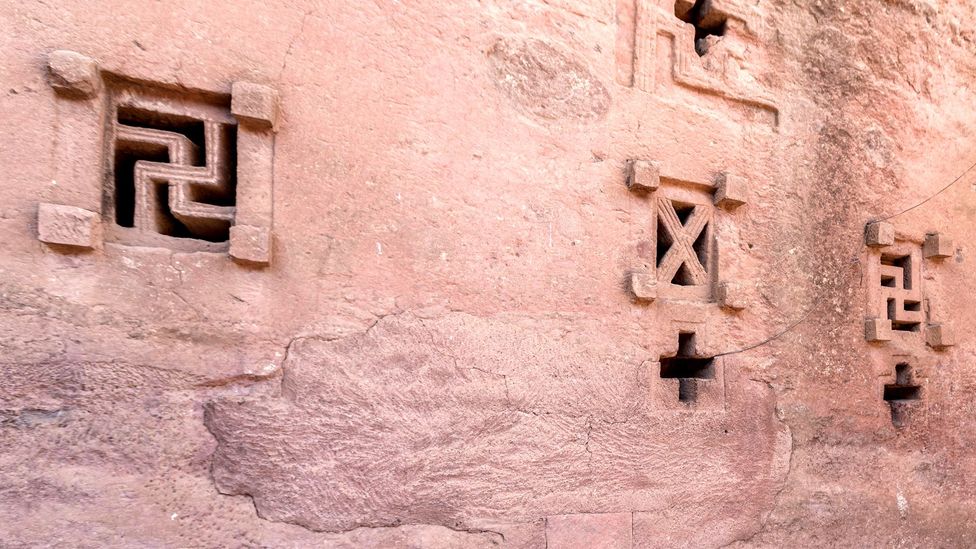The Swastika: A symbol of prosperity or terror?

If you are familiar with the swastika, then I may be right to guess that the first thing that came to mind when you saw the above image was the Holocaust or Nazis. If that is true, you are indeed right. However, it will perhaps interest you to know that the swastika was originally a symbol of prosperity and good luck.
The swastika symbol, an equilateral cross with arms bent at 90° angles, usually to the right (clockwise direction), is an ancient symbol that the Jewish Virtual Library reports as being more than 3,000 years old. The word, “swastika” itself, is said to have originated from the Sanskrit svastika, which means “good fortune” or “well-being.” In 1871, Heinrich Schliemann, the german archaeologist, who made discovering the ancient city of Troy using Homer’s Iliad his life’s goal, found the hooked cross (swastika) on the site of ancient Troy on the Aegean coast of Turkey. Although he had set out to discover Troy, Schliemann found at least 1,800 variations of the swastika, on shards of pottery and sculpture throughout the layers. History has it that Schliemann was the one who brought the swastika to Germany and ultimately had it stolen by Adolf Hitler, who adopted it as the symbol of the Nazi Party in 1920.

I do not intend to go into all the details about Nazis and the Holocaust, although you can read more about it here, or watch documentaries on YouTube. However, if you are wondering why this was the symbol chosen by Hitler, then you should know that after Schliemann had shed a lot of light on the swastika, it became widely used in the 20th century in Europe as a symbol of good luck and auspiciousness. Over time, it was taken up by racist groups as a symbol of “Aryan identity” and German nationalist pride. Hence, it is no surprise that the Nazi Party adopted the swastika (Hakenkreuz in German) as its symbol.
![Picture postcard showing a crowd of saluting Germans superimposed on an enlarged image of Hitler and a Nazi stormtrooper. [LCID: 14951]](https://encyclopedia.ushmm.org/images/large/534200f9-59ec-4907-ac65-fd6045027681.jpg)
On March 12, 1933, President Paul von Hindenburg and Adolf Hitler issued a decree that stated that henceforth the old German Imperial flag (black-white-red) was to be flown together with the swastika flag. “These flags,” the edict spelt out,
“connect the glorious past of the German Empire to the powerful rebirth of the German nation. Together they embody the power of the state and the inner solidarity of the national circles of the German people!”
On May 19, 1933, the Nazi Government prohibited the “symbols of German history, of the German state, and the national revolution from being publicly used in a way that was likely to damage the feeling of dignity of these symbols.” On September 15, 1935, the Reich Flag Law was passed, which essentially stated that the Swastika flag would constitute the official flag of the German Reich. On the same day, another law, the Law for the Protection of German Blood and German Honor, was passed which prohibited marriages and sexual relations between citizens of “German or those of kindred blood” and Jews. But again, I digress. By now, you must have gotten how the swastika symbol ceased to represent well-being for all and became a symbol of superiority and “pure blood”. As another little digression, this reminds me of the recent tribalistic views that have been flying about with respect to the Lagos State Gubernatorial Elections.
After Nazi Germany was finally defeated in 1945, the bans were reversed and the Nazi symbols were banned in several countries. Today in Germany and other European states, public display of Nazi symbols, including on the Internet, is prohibited by law, and individuals violating such terms are subject to criminal proceedings. However, in places like the United States, it is legal to display Nazi symbols and propaganda because of the country’s traditions and laws protecting free speech.
Regardless of the foregoing, in India, the swastika continues to be the most widely used auspicious symbol of Hindus, Jainas, and Buddhists. However, to persons like the 93-year-old Holocaust survivor Freddie Knoller, who says to the BBC, “For the Jewish people the swastika is a symbol of fear, of suppression, and of extermination. It’s a symbol that we will never ever be able to change,” it is understandable that the symbol is one that they would rather not catch a glimpse of.
I understand that as a Nigerian, you may not be sure where you stand with this but I hope that this article spurs you to take an interest in history, and the hidden meanings behind popular symbols. If you are not sure what to start with, you can start by reading about the holocaust. And just in case it might interest you to know, the swastika turned counterclockwise is known as sauvastika.
